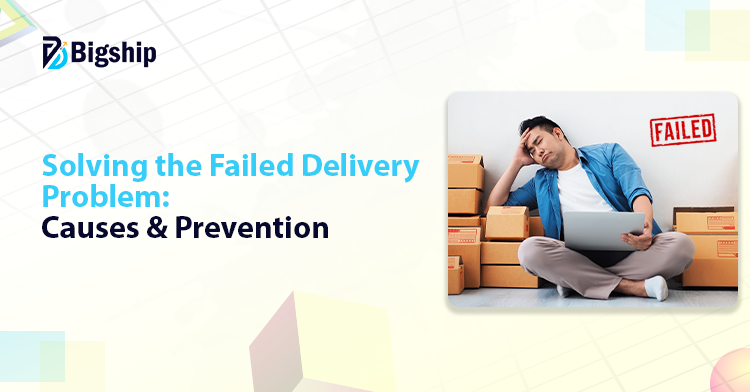Failed deliveries are a major drawback in the logistics business. They can have a direct impact on your business in terms of increasing operational costs, delayed shipments, and irritated customers. Finding that 1 out of 5 packages goes undelivered on the first attempt means very expensive re-deliveries, which can damage the company’s reputation due to a lack of commitment.

In this blog, we’ll break down the major reasons for failed deliveries and ensure your shipping runs smoothly.
Understanding the Concept of Delivery Attempts
A delivery attempt refers to the instance when a courier company tries to deliver a package to the recipient. If the recipient is unavailable or the address is incorrect, the delivery fails. In most cases, logistics companies make two or more delivery attempts before marking the package as undeliverable or sending it back to the sender (Return to Origin or RTO).
Tracking delivery attempts is essential for businesses to identify delivery issues early, improve success rates on the first try, and enhance customer satisfaction.
How Often Does the First Delivery Attempt Succeed?
The success of a first delivery attempt depends on several factors, including the efficiency, the location, and the recipient’s availability. A strong First Attempt Delivery Rate (FADR) typically falls between 90% and 100%.
Top 11 Reasons Why Your Delivery Might Fail
- Wrong or Incomplete Address: If the street name is wrong, the apartment number is missing, or if there is any other missing information like the PIN code, it could lead to a delay or return of the parcel. This usually happens during checkout due to typing errors.
- Customer Not Available: When the recipient is not available on delivery, the courier would have to come again later, thus leading to a delay.
- No Delivery Instructions: Instructions such as “leave at the back gate” or “call before delivery” make the courier’s job a lot easier. When such instructions don’t exist, it’s harder for the courier to find the right spot, especially if the delivery is in a large complex.
- Restricted Delivery Locations: Destination premises such as gated societies or offices, or army areas usually require special permission for entry by the courier. If such permission is not given, the package will be taken back by the courier.
- No Response from Customer: If the delivery agent attempts to call or text the recipient but receives no response, delivery may not be possible. The contact details supplied should be correct and reachable.
- Wrong Contact Information: If the wrong phone number or e-mail address is provided, contacts cannot be established between the courier and the customer, should he or she so require. Delivery failures occur quite frequently.
- Bad Weather or Unexpected Events: Floods, storms, roadblocks, strikes, or political events can be a good excuse to slow down deliveries. Having these working against you is just unfair.
- Damaged or Lost Parcels: Sometimes, the parcels get damaged or lost during transportation. Generally, it’s just bad handlings or poor packaging that lead to such difficulty.
- Oversized or Heavy Packages: The package may be too large or heavy to fit into the specified vehicles, thus necessitating delayed delivery or special arrangements.
- Shortage of Drivers or Vehicles: Sometimes, during busy hours, because of a shortage of staff, there aren’t enough staff members in vehicles to make deliveries. This causes delays or missed deliveries.
- Package Refusal by Customer: In some cases, the customers refuse the delivery because the incorrect item was delivered, there were unexpected extra charges applied, or they were simply not happy with the item.
What Happens After the Missed First Delivery Attempt?
Here is what generally happens:
- Second or Final Attempt at Delivery: Most post offices usually make a second attempt to deliver the item within 24 to 48 hours. When a delivery fails, the customer might usually be given the chance to amend or update their details. Only a few companies permit one more attempt before declaring the consignment for return.
- Customer Contact and Address Verification: Following failed delivery, customers receive notice by SMS, e-mail, or app notifications. If the supplied number or address is wrong, an update is requested from the recipient before the next delivery attempt is made.
- Parcel Withdrawal Allowed: Dropping the parcel at a nearby pickup location or courier office is seen as an alternative when another attempt at delivery is not possible. The customer then has only a few days to pick up the package before it goes back to the seller.
- Returned to Sender: Where the package is not delivered once more or the customer declines to accept the delivery, the package is further marked “Return to Sender”. Additional charges to the business will be incurred on this and may result in delays in any reimbursement or replacement.
- Customer Support Follow-up: In urgent cases for important or urgent deliveries, companies might directly approach the client, offer new time slots for delivery, and at times even reroute the parcels from an alternate division to ensure delivery.
What Happens If Delivery Fails?
A delivery failure may create a distance for both businesses and customers to grow. This is what usually unfolds when deliveries keep failing:
- Increased Costs for Businesses: Every failed delivery entails an extra cost. So, you have to pay another redelivery charge and, if returned, you might have to pay shipping charges twice: once to the customer and then to get the item back.
- Unhappy Customers & Lost Trust: Customers today expect deliveries to be fast and reliable. Any such delivery comes with a delay, or is never delivered at all, and that causes frustration. This could lead to bad reviews, complaints, or customers who decide never to buy from you again.
- Inventory and Logistics Problems: If the products don’t get to the customer, the products get stuck in transit, or the products get returned, and that disorganizes your inventory record. You may also need additional storage for returned items and further time to verify, restock, or resell those items.
How to Avoid Failed Deliveries: 6 Proven Practices
Failed deliveries can be costly. The good thing is that most failed deliveries can be avoided if it’s done with the right strategy. Here are six practices to help reduce delivery failures and increase success rates:
1. Real-Time Tracking with Alerts: Keep your customer aware of delivery processes through SMS, e-mail, or WhatsApp with live tracking and scheduled updates. A transparent process helps to build trust and gives the customer a chance to receive the delivery.
2. Validate Address During Checkout: One major cause of failed delivery is having an incorrect or incomplete address. You can use validation tools to detect mistakes and verify the correctness of shipping details early.
3. Optimization of Last-Mile Delivery Routes: Delivery partners can use AI-based solutions to prioritize traffic avoidance, fuel optimization, and management of multiple stops as their priorities.
4. Provide Flexible Delivery Services: Let customers stand a chance in selecting delivery windows, pickup locations, or locker services. Flexibility increases end-case scenarios for completing first delivery attempts.
5. Make Return and Redelivery Policies Stronger: Have a clear, customer-friendly option to reschedule failed deliveries. A seamless, well-structured return and redelivery process can prevent further issues.
6. Maintain Clear Communication: Communication is an effective way that helps to reduce confusion. Regularly inform about delivery status and any delays, issues, or changes in delivery via email, SMS, or app notifications.
A Simple 3-Step Approach to Handling Failed Deliveries
Failed deliveries occur despite the best planning. What is important is how soon and effectively one handles such incidents. Here is a simple three-step approach to smoothly avoid such situations:
- Find Out What Went Wrong: The first step is to understand what went wrong with the delivery. The most common causes are a wrong or incomplete address, the customer not being at home, restrictions on delivery to certain locations, bad weather conditions, or simply delays by the courier.
- Inform the Customer and Offer a Fix: Once you find the issue, send a message to your customer through either an SMS, email, or even a quick call, and set a new date for delivery, change the address for delivery, or choose to pick up the parcel from a local pickup point.
- Reattempt Delivery: Quickly act upon the customer’s response. This may require reattempting a delivery or returning, refunding, or replacing the lost or damaged product. Easy and transparent processes will help maintain trust and satisfaction.
4 Delivery Trends That Help to Reduce Failed Deliveries
With customer expectations rising and online shopping growing, businesses require smarter means of delivery and hence require unmissable deliveries. Here are the four key concepts trending in logistics, according to which misses are being reduced:
- Route Planning Using AI: AI-powered route planning takes into account traffic, weather, and other external factors to suggest the fastest and most efficient delivery routes. This reduces time spent on the road, lowers fuel and delivery costs, and minimizes the chances of failed or repeated delivery attempts.
- Address Validation: Wrong or incomplete addresses are reasons that deliveries fail to reach customers. Such errors can now be avoided since tools using machine learning techniques auto-check and correct the addresses before the package is sent out.
- Real-Time Tracking and Instant Notifications: Clients nowadays want to track their orders in real-time. Through GPS tracking and automated notifications, customers can keep an eye on their deliveries, get alerts about any delay, and even reprogram the delivery if required.
- A Flexible Delivery Format: Package deliveries have become way flexible, wherein parcel lockers can be used 24/7, doorstep drop-offs are contactless, and rescheduling or rerouting of packages is possible.
Bigship: Making Deliveries Smarter, Faster & More Reliable
In the fast-moving world of e-commerce, failed deliveries are a dent on customer satisfaction and an increase in costs. Bigship aims to reduce the failures in delivery and improve operational efficiency. Here’s what it does:
- Live Tracking & Notifications: Updates in real time for customers and sellers, thus avoiding confusion and missed deliveries.
- Auto Address Validation: Detects and fixes address errors before dispatch, ensuring parcels reach the right place.
- Easy Reschedule & Return Handling: Let customers reschedule deliveries easily and simplify return processes for smoother operations.
- Reliable Courier Network: Integrated with reputed delivery partners, ensuring fast, secure, and affordable last-mile delivery.
Conclusion
Failed deliveries don’t just disrupt logistics; they also affect customer trust, thus causing operational costs to rise and growth in the business to slow down. By embracing effective tools and proven strategies-the use of dynamic route planning, real-time monitoring, and flexible delivery choices-challenges can be converted into opportunities.
With Bigship, all deliveries should be efficient, reliable, and customer-touching experiences. Are you ready to reduce the number of failures and simplify your shipment?
Sign up with Bigship today and take full control over your deliveries.





